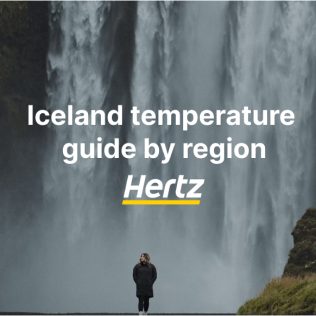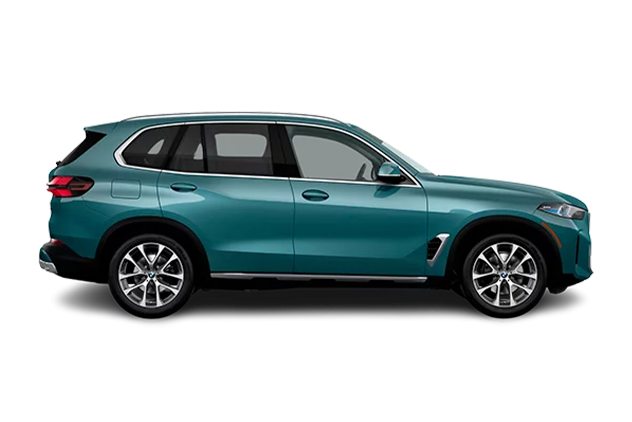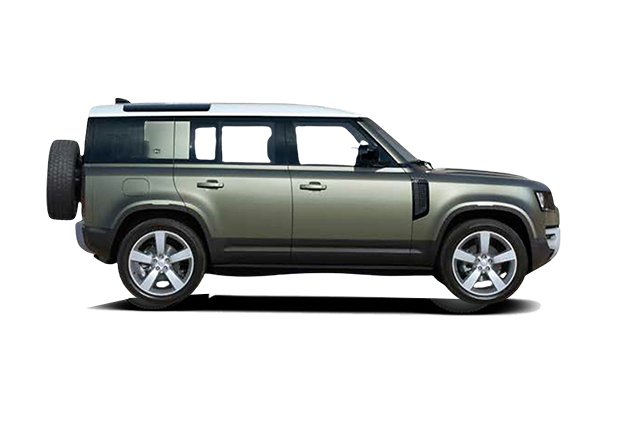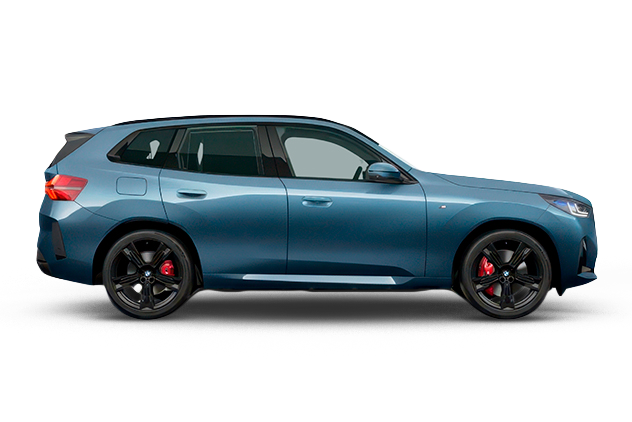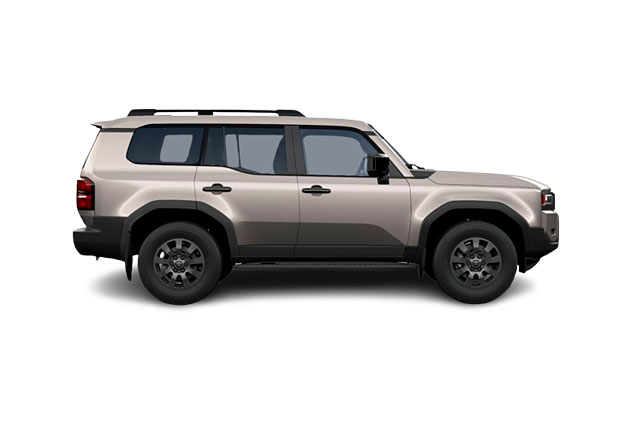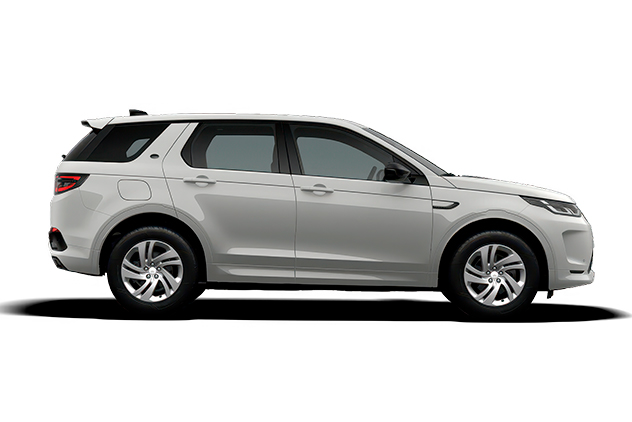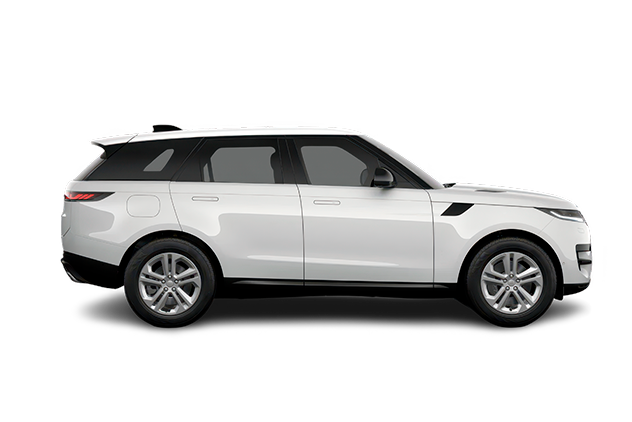Planning a trip to Iceland? One of the most important things to know before you hit the road is how the weather changes — not just by season, but by location. While many travelers search for Iceland weather by months of the year, the reality is that the climate in Iceland can vary dramatically between the north and south, the coast and the Highlands, or even from one fjord to the next.
That’s why we’ve created this regional Iceland temperature guide, giving you a clear breakdown of average temperatures across the country — including Reykjavík, Vík, Egilsstaðir, Akureyri, Ísafjörður, Stykkishólmur, and the Highlands. You’ll find easy-to-read tables for each location, with month-by-month insights from January and February through to the warmest month of the year.
But this isn’t just a weather blog. As Iceland’s trusted car rental company, we’ve also included practical driving advice and recommended car types based on real weather conditions and road conditions in each region. Whether you’re chasing the aurora borealis in the north, visiting hot springs along the South Coast, or heading to the remote Highlands in summer, we’ll help you find the right vehicle for a safe and unforgettable trip to Iceland.
Let’s get started — the midnight sun, northern lights, and Iceland’s ever-changing weather are waiting.
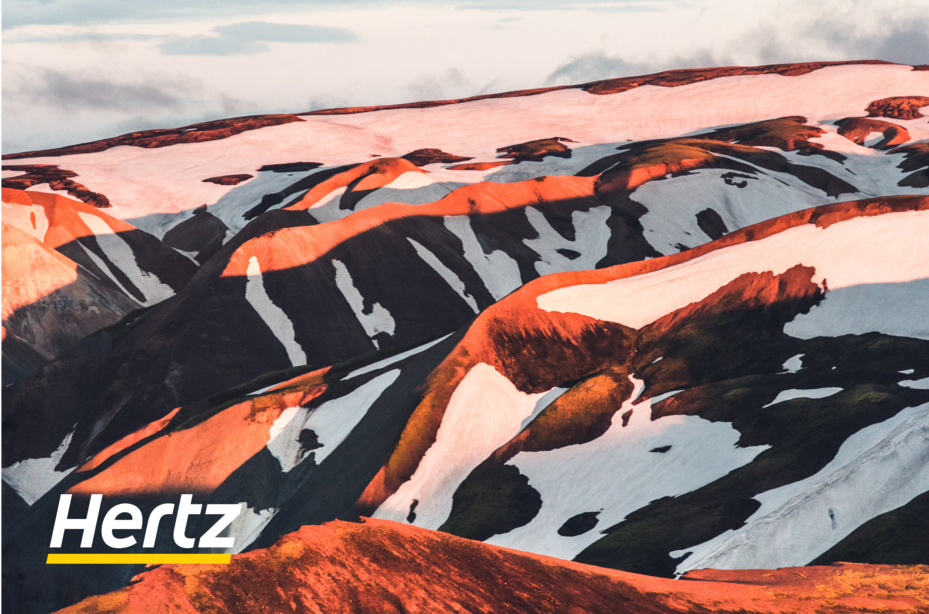
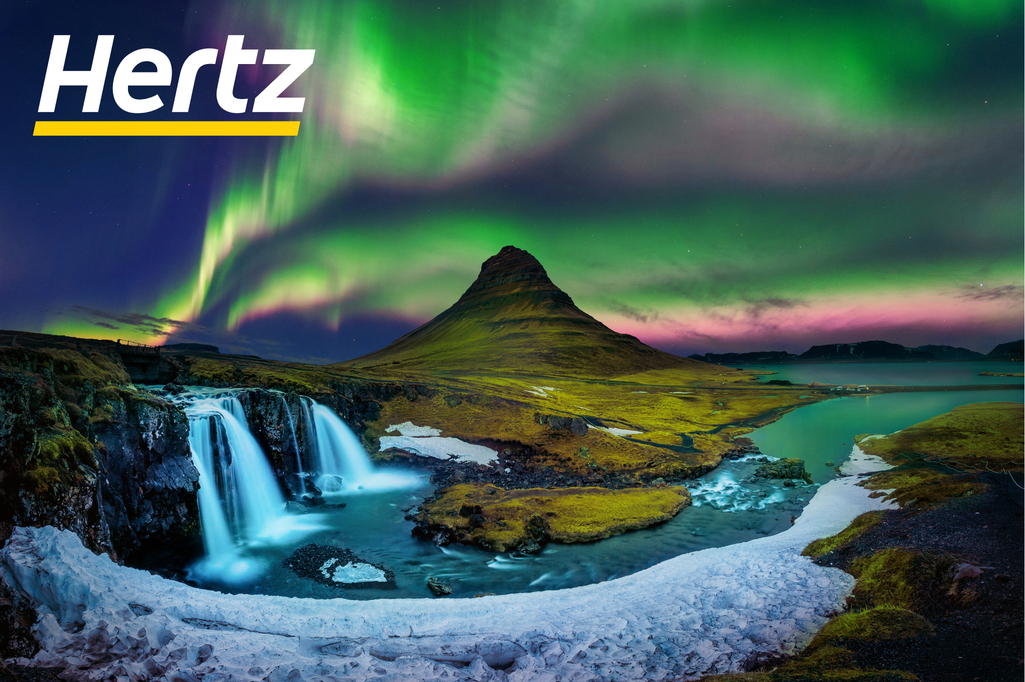
How Iceland’s geography shapes the weather
Iceland might look small on the map, but its geography packs a punch. Sitting just below the Arctic Circle and surrounded by the North Atlantic, the island is shaped by glaciers, volcanoes, coastlines, and highland plateaus — all of which influence local climate conditions.
For example, the south coast is milder in winter but wetter all year round, earning it a reputation for having some of the wettest months in Iceland. Meanwhile, the north and interior Highlands are colder and drier but often get heavier snow in winter. Coastal areas are often windy, while sheltered fjords in the east or west can feel more stable, especially in summer.
One key reason Iceland doesn’t get as cold as you might expect for a Nordic country is the Gulf Stream — a warm ocean current that keeps coastal temperatures a bit higher than those found in inland or Arctic regions. That’s why even in the darkest months of winter, temperatures in places like Reykjavík often hover just around freezing, rather than plummeting to extreme sub-zero levels.
But don’t let the averages fool you — weather conditions in Iceland can shift rapidly, even within the same day. That’s why checking daily updates on vedur.is and road.is is essential, especially if you’re planning activities like ice cave tours, hiking in Iceland, or road trips through remote areas.
Now let’s break down Iceland’s average temperatures by region — and which car to rent depending on the time of year and where you’re headed.
Here’s the region map of Iceland and the Iceland highland is the part in the middle of Iceland:
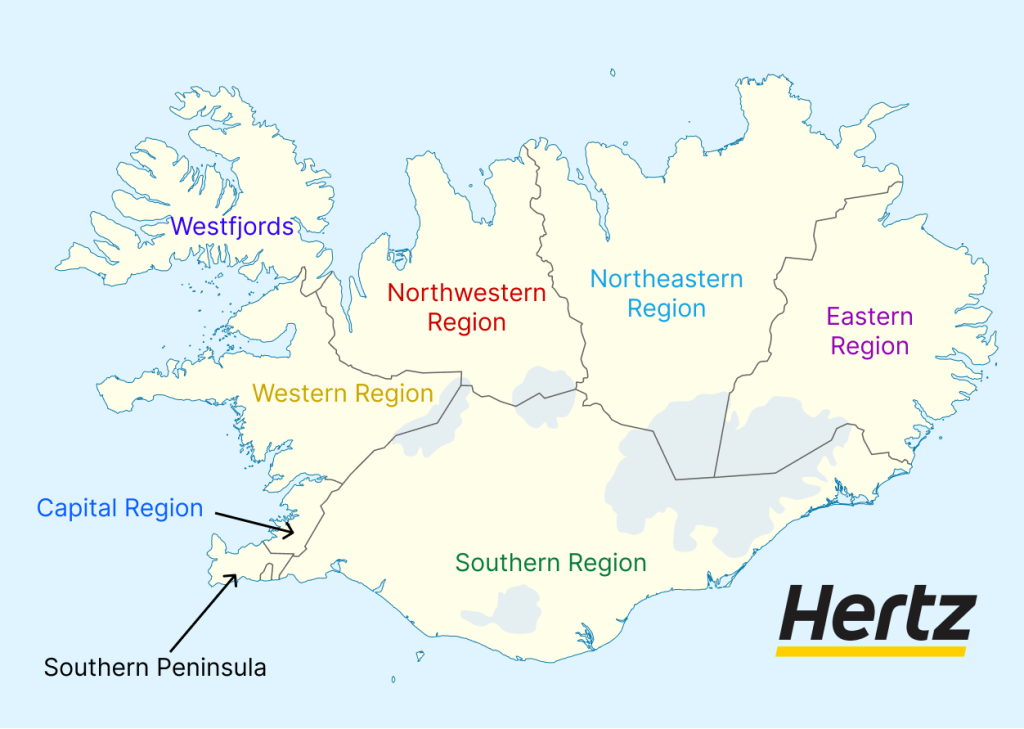
Weather and average temp in Reykjavík & the capital area (Southwest Iceland)
As Iceland’s largest city and most common starting point for a road trip, Reykjavík offers a good sense of the climate in Iceland’s southwest. Thanks to the nearby ocean and low altitude, winters here are relatively mild, and summers are cool but pleasant.
Here’s a look at the average temperature in Reykjavík throughout the months of the year:
| Month | Average High (°C) | Average Low (°C) |
| January | 2°C | -2°C |
| February | 2°C | -2°C |
| March | 3°C | -2°C |
| April | 6°C | 0°C |
| May | 9°C | 4°C |
| June | 12°C | 8°C |
| July (warmest) | 14°C | 9°C |
| August | 13°C | 8°C |
| September | 10°C | 6°C |
| October | 6°C | 2°C |
| November | 4°C | -1°C |
| December | 2°C | -2°C |
What to expect in each season
- Winter (Nov–Mar): Frequent wind, occasional snow, icy pavements. Daylight is short — just 4–5 hours in the darkest months.
- Spring (Apr–May): Still chilly, but longer daylight and less snow. Great time for city walks and hot springs.
- Summer (Jun–Aug): Comfortable for sightseeing, with long days and the midnight sun peaking in late June.
- Autumn (Sep–Oct): Cooler again, more rain, and golden foliage — a great time to visit Iceland without the crowds.
Best car to rent in Reykjavík
For stays mainly in the capital or short drives to nearby attractions like the Golden Circle, a small 2WD is usually sufficient, especially in summer months. But if you’re visiting in winter, a 4WD adds extra safety in case of sudden frost or slippery road conditions.
Planning to see the northern lights in Iceland? A rental car gives you the flexibility to leave the city lights behind — just check the aurora borealis forecast on the Icelandic Met Office site and head out on a clear night.
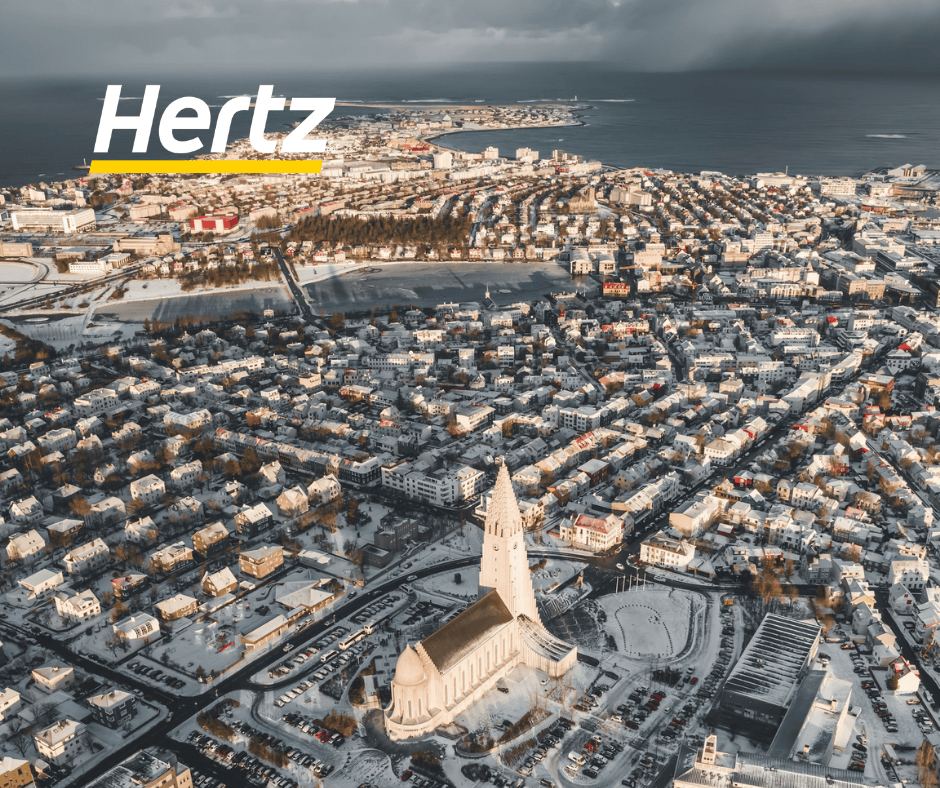

Weather and average temp in South Iceland (Vík and surrounding areas)
Known for its black sand beaches, dramatic cliffs, and powerful waterfalls, South Iceland is one of the most visited regions in the country. The town of Vík, located just by the coast, is a useful reference point for the area’s climate and weather conditions.
Despite being further south, Vík is actually wetter and windier than Reykjavík, especially during the wettest months (fall and early winter). Still, the temperatures here are relatively moderate thanks to the North Atlantic influence.
Here’s the average temperature for Vík by month:
| Month | Average High (°C) | Average Low (°C) |
| January | 3°C | -1°C |
| February | 3°C | -1°C |
| March | 4°C | 0°C |
| April | 6°C | 2°C |
| May | 9°C | 5°C |
| June | 12°C | 8°C |
| July (warmest) | 13°C | 9°C |
| August | 13°C | 8°C |
| September | 10°C | 6°C |
| October | 7°C | 3°C |
| November | 4°C | 1°C |
| December | 3°C | -1°C |
What to expect in each season
- Winter (Nov–Mar): Very windy, rainy, and sometimes icy. Storms are common — be alert to weather warnings.
- Spring (Apr–May): Greener landscapes emerge, though rain is still frequent.
- Summer (Jun–Aug): Beautiful light, ideal for seeing waterfalls and going hiking in Iceland — just prepare for sudden showers.
- Autumn (Sep–Oct): Impressive scenery changes with strong winds and shorter days.
Best car to rent in South Iceland
In summer months, you can often get by with a 2WD car, especially if you’re sticking to Route 1 Ring Road and visiting highlights like Skógafoss or Reynisfjara Beach.
But from October to April, we strongly recommend renting a 4WD or SUV. The south is notorious for unpredictable weather conditions, sudden road closures, and strong side winds — especially on exposed stretches like Mýrdalssandur. If you’re planning to visit ice cave tours near Vatnajökull, having a 4WD ensures safer travel to the meeting points.

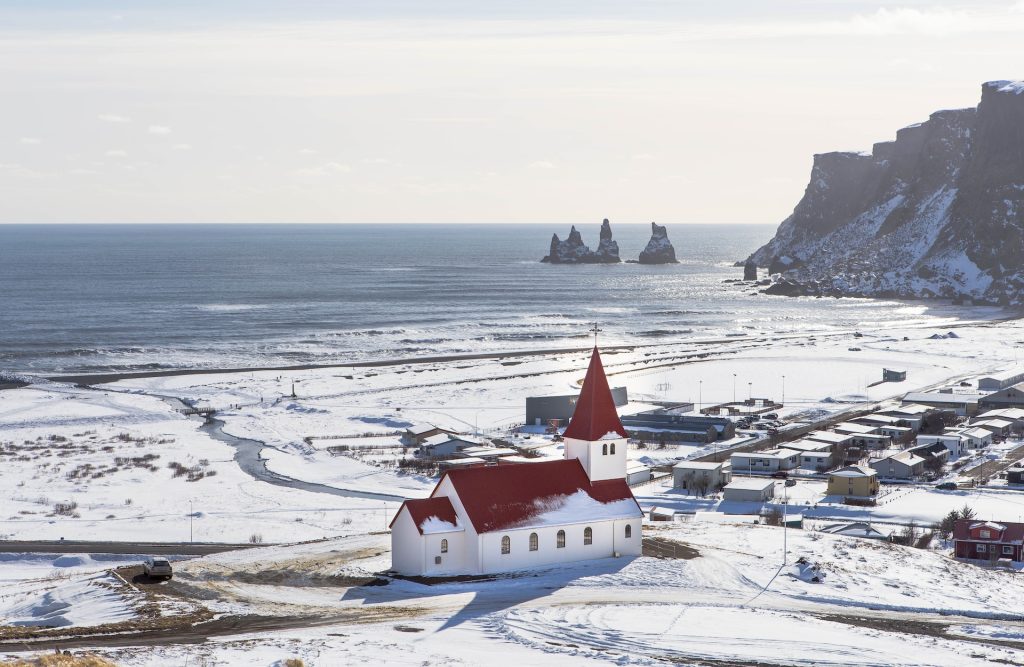
Weather and average temp in East Iceland (Egilsstaðir and surrounding fjords)
Often overlooked but stunningly scenic, East Iceland is known for its quiet fjords, reindeer herds, and summer festivals. The town of Egilsstaðir, the region’s largest settlement, sits inland — meaning it often sees more temperature extremes compared to coastal towns.
Summers here can feel surprisingly warm on sunny days, while winters bring icy roads and snow-covered passes. If you’re planning a trip to Iceland with long drives and few crowds, East Iceland is a gem — but it requires some extra preparation, especially in colder months.
Here’s the average temperature in Egilsstaðir by month:
| Month | Average High (°C) | Average Low (°C) |
| January | -1°C | -6°C |
| February | 0°C | -5°C |
| March | 2°C | -4°C |
| April | 6°C | -1°C |
| May | 10°C | 3°C |
| June | 14°C | 7°C |
| July (warmest) | 15°C | 8°C |
| August | 13°C | 7°C |
| September | 9°C | 3°C |
| October | 4°C | -1°C |
| November | 0°C | -4°C |
| December | -1°C | -6°C |
What to expect in each season
- Winter (Nov–Mar): Cold, with icy roads and occasional snowstorms. Mountain passes can close.
- Spring (Apr–May): Melting snow brings green valleys, but highlands and inland roads may still be difficult.
- Summer (Jun–Aug): Great driving weather, long days, and the chance to experience local culture and events.
- Autumn (Sep–Oct): Colourful landscapes, cooler temperatures, and rising rainfall.
Best car to rent in East Iceland
For summer travel, a compact 2WD can work — especially if you’re sticking to the Ring Road. But if you plan to explore mountain roads or drive over passes like Öxi, a 4WD vehicle offers more comfort and safety.
During the darkest months, East Iceland can be more isolated, with snow and ice lingering on roads. A 4WD SUV is a must from October to April, especially if you’re venturing inland or through remote fjords.
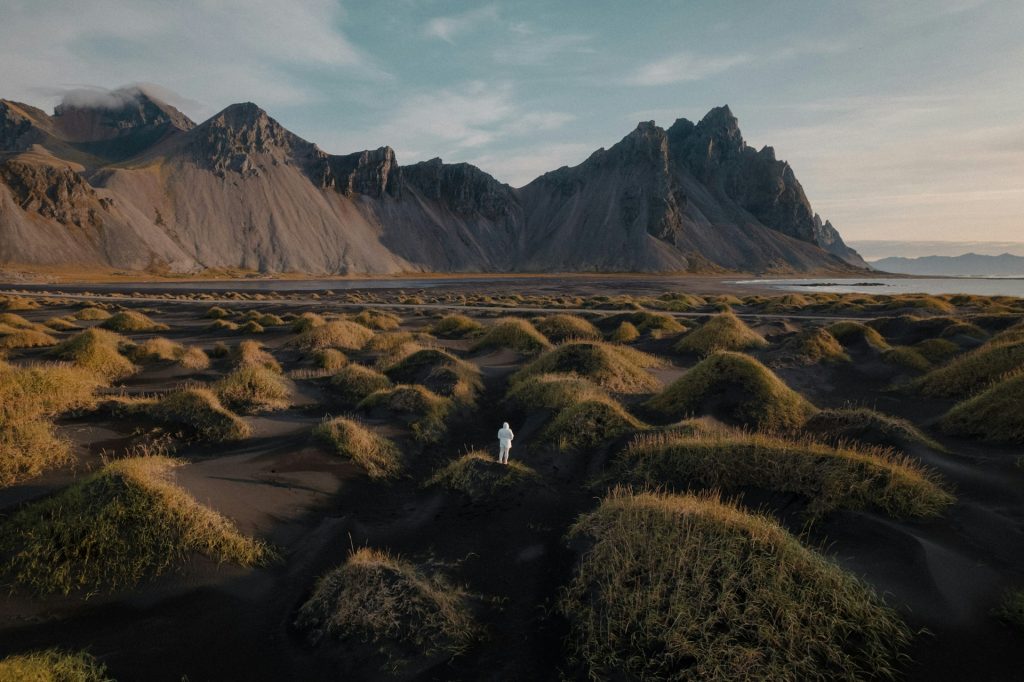
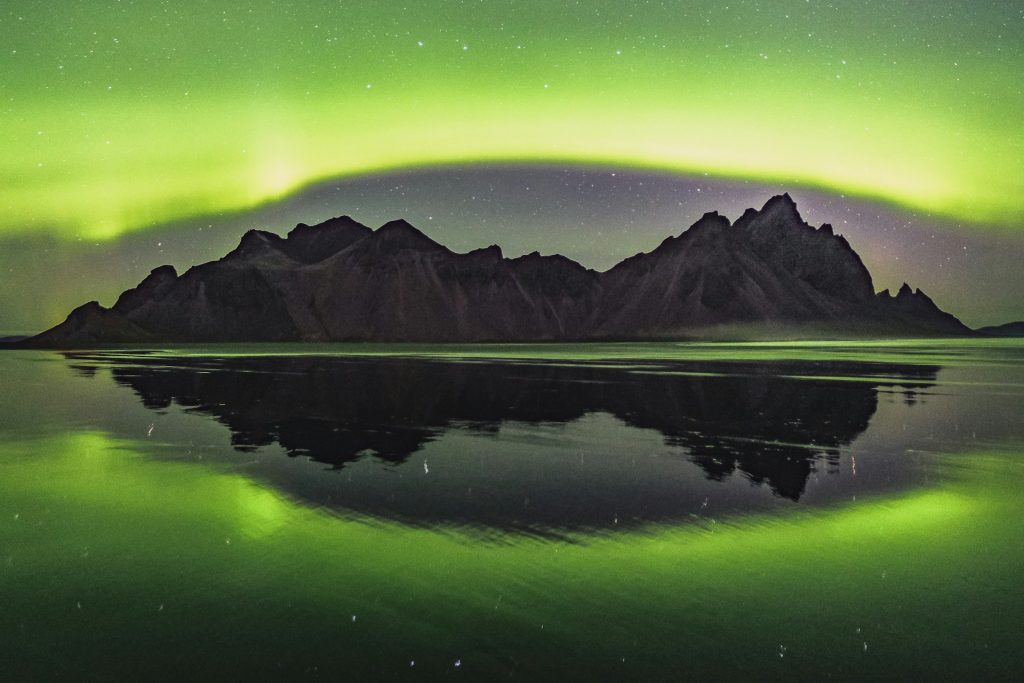
Weather and average temp in North Iceland (Akureyri and Mývatn area)
North Iceland brings a more Arctic feel to your trip to Iceland, especially in winter. The city of Akureyri, often called the “Capital of the North,” offers a good balance of culture, nature, and accessibility. Just east of Akureyri lies the Mývatn area, known for hot springs, volcanic craters, and active geothermal landscapes.
This region lies closer to the Arctic Circle, so winters are colder and snowier, while summers are bright and refreshing, perfect for hiking in Iceland and spotting midnight sun in June.
Here’s the average temperature for Akureyri throughout the year:
| Month | Average High (°C) | Average Low (°C) |
| January | -1°C | -6°C |
| February | 0°C | -5°C |
| March | 2°C | -4°C |
| April | 6°C | -1°C |
| May | 10°C | 3°C |
| June | 13°C | 7°C |
| July (warmest) | 14°C | 8°C |
| August | 13°C | 7°C |
| September | 9°C | 3°C |
| October | 4°C | -1°C |
| November | 0°C | -4°C |
| December | -1°C | -6°C |
What to expect in each season
- Winter (Nov–Mar): Snow-covered landscapes, calm wind, and frequent sightings of the northern lights in Iceland.
- Spring (Apr–May): Icy mornings and thawing roads — a transition season with fewer crowds.
- Summer (Jun–Aug): Dry, cool air and endless light — ideal for road trips and aurora borealis-free night skies (too bright!).
- Autumn (Sep–Oct): Early snow is possible; fewer tourists and beautiful fall colours.
Best car to rent in North Iceland
If you’re sticking around Akureyri or driving to Lake Mývatn in the summer months, a 2WD rental is often enough. The roads are paved and well-maintained.
However, if you’re visiting in January and February or venturing toward places like Dettifoss or Húsavík, a 4WD or SUV is a smarter choice. North Iceland gets real winter — and if you’re chasing the aurora borealis, having the right car can make or break your adventure.
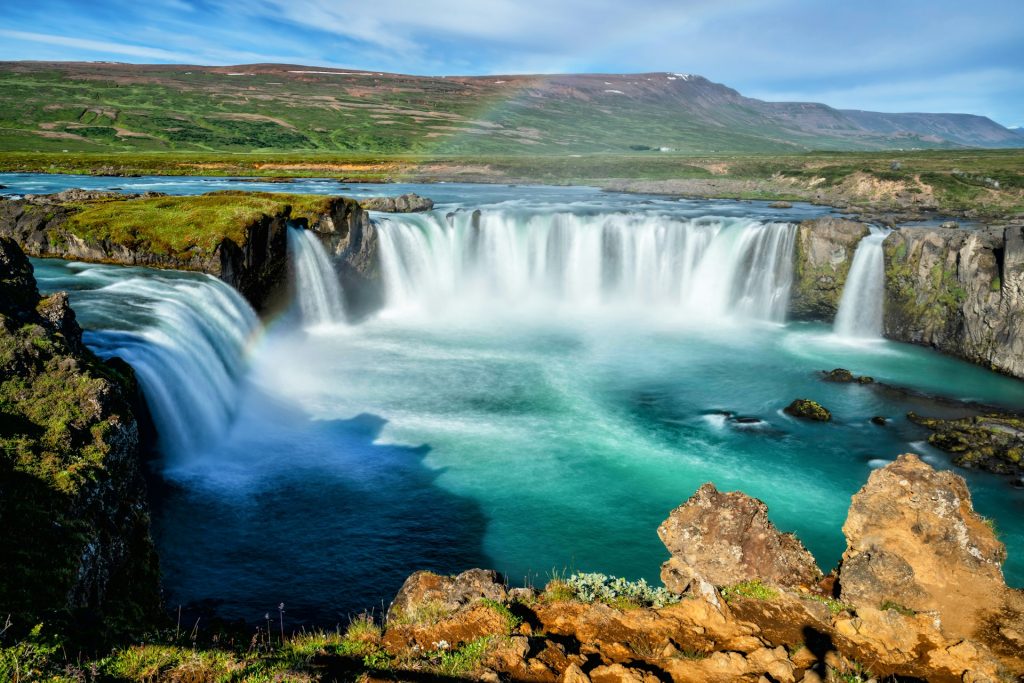
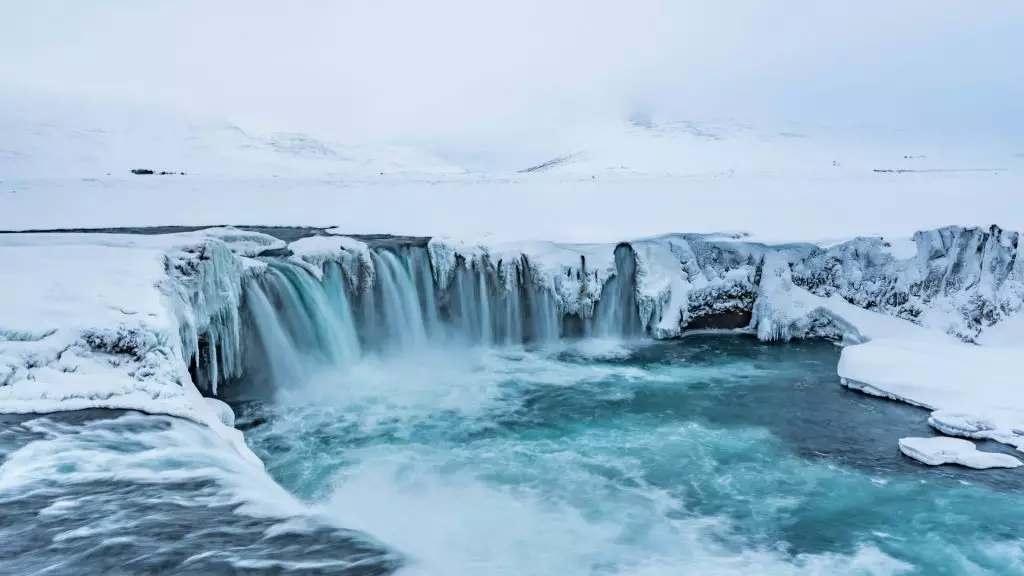
Weather and average temp in Westfjords of Iceland (Ísafjörður and surrounding region)
The Westfjords are one of Iceland’s most remote and breathtaking regions, with steep cliffs, narrow fjords, and tiny fishing villages. The largest town here, Ísafjörður, sits nestled between towering mountains and the sea, offering a glimpse into life on the edge of the Arctic.
This region is known for harsh winters, challenging road conditions, and long hours of darkness during the darkest months. But in summer, it becomes a paradise of hiking trails, puffin cliffs, and midnight sun light — ideal for travellers looking to explore Iceland off the beaten path.
Here’s the average temperature in Ísafjörður by month:
| Month | Average High (°C) | Average Low (°C) |
| January | -1°C | -6°C |
| February | 0°C | -5°C |
| March | 1°C | -4°C |
| April | 4°C | -1°C |
| May | 7°C | 2°C |
| June | 10°C | 5°C |
| July (warmest) | 12°C | 7°C |
| August | 11°C | 6°C |
| September | 7°C | 3°C |
| October | 3°C | 0°C |
| November | 0°C | -3°C |
| December | -1°C | -5°C |
What to expect in each season
- Winter (Nov–Apr): Roads often close due to snow, avalanches, and poor visibility. Limited daylight makes driving difficult.
- Spring (May): Transition period; roads begin to open, though mountain passes may still be closed.
- Summer (Jun–Aug): Ideal time to visit. Bright skies, open roads, and access to iconic sites like Dynjandi Waterfall.
- Autumn (Sep–Oct): Roads remain open early in the season, but the first snows can arrive quickly.
Best car to rent in the Westfjords
If you’re planning a trip to the Westfjords, timing matters. We strongly advise visiting only in summer, unless you have deep experience with Icelandic winter driving.
Even then, a 4WD vehicle is essential. Gravel roads, sharp turns, and high-altitude passes like Hrafnseyrarheiði require traction and clearance — even in fair weather. In the wettest months, having a reliable car isn’t just about comfort — it’s about safety.
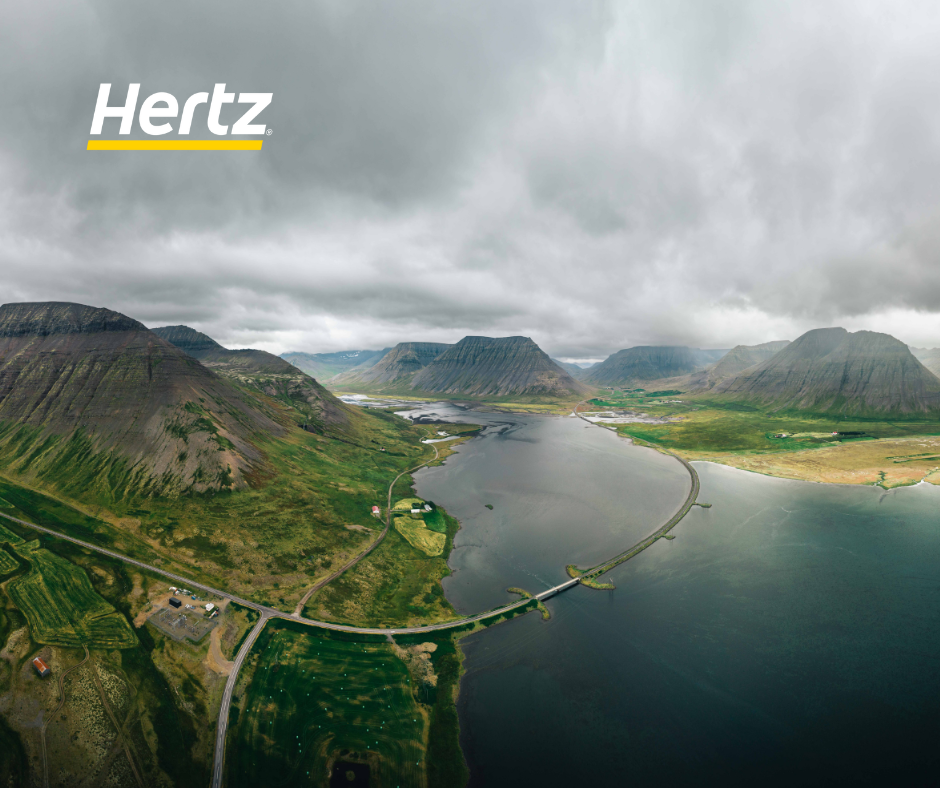
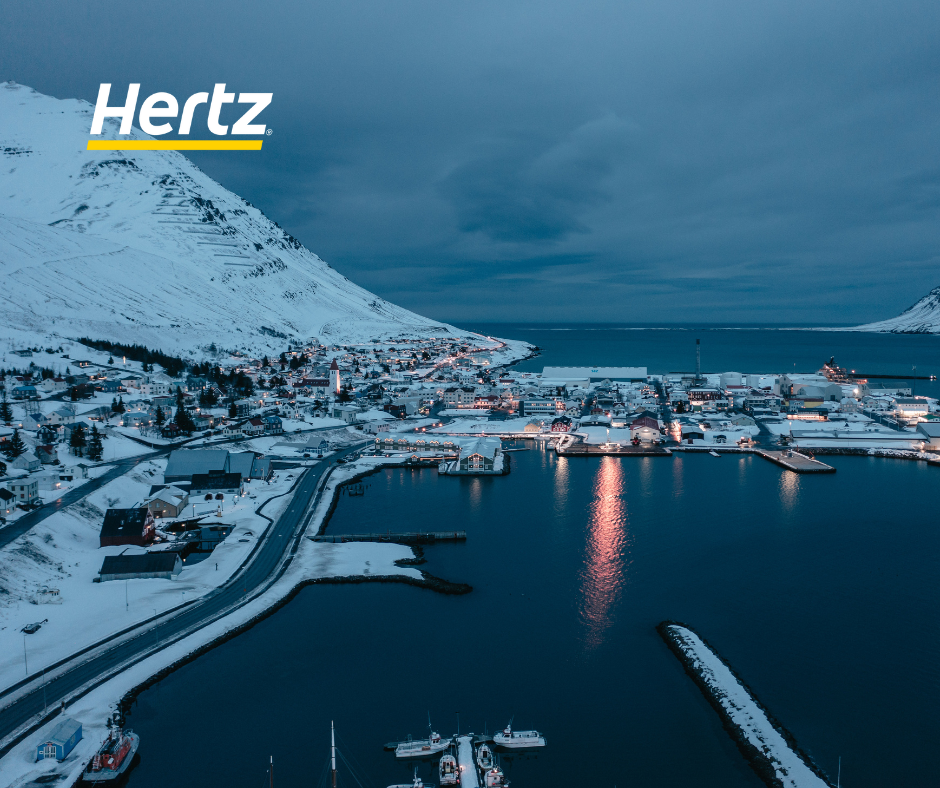
Weather and average temp in West Iceland & Snæfellsnes Peninsula (Stykkishólmur area)
Nicknamed “Iceland in Miniature,” the Snæfellsnes Peninsula is where you’ll find black sand beaches, lava fields, glaciers, and fishing towns — all within a few hours’ drive from Reykjavík. The region’s climate is shaped by both ocean breezes and volcanic terrain, creating microclimates that can change quickly.
The town of Stykkishólmur, sitting on the northern side of the peninsula, offers a good reference point for the area’s weather conditions. While winters can be cold and windy, the summers are among the driest in the country, making this one of the best regions for a summer road trip.
Here’s the average temperature in Stykkishólmur by month:
| Month | Average High (°C) | Average Low (°C) |
| January | 2°C | -3°C |
| February | 2°C | -2°C |
| March | 3°C | -1°C |
| April | 6°C | 1°C |
| May | 9°C | 4°C |
| June | 12°C | 7°C |
| July (warmest) | 14°C | 9°C |
| August | 13°C | 8°C |
| September | 10°C | 6°C |
| October | 6°C | 2°C |
| November | 3°C | -1°C |
| December | 2°C | -2°C |
What to expect in each season
- Winter (Nov–Mar): Snow and strong winds are common, especially near Snæfellsjökull glacier.
- Spring (Apr–May): Great for photography — snow on the peaks, but green fields by the coast.
- Summer (Jun–Aug): One of the best times to visit Iceland. Long days, good visibility, and fewer weather disruptions.
- Autumn (Sep–Oct): Changing skies and golden landscapes — watch out for sudden fog or slippery roads.
Best car to rent in Snæfellsnes
For a summer visit, a 2WD car is often enough if you’re sticking to paved roads between places like Arnarstapi, Búðir, and Kirkjufell. However, if you’re visiting in shoulder seasons or winter, a 4WD is much safer due to wind, coastal storms, and gravel roads.
Bonus tip: This is a great region for hot springs and short hikes. Having your own rental car lets you explore more freely, especially at sunrise or sunset.
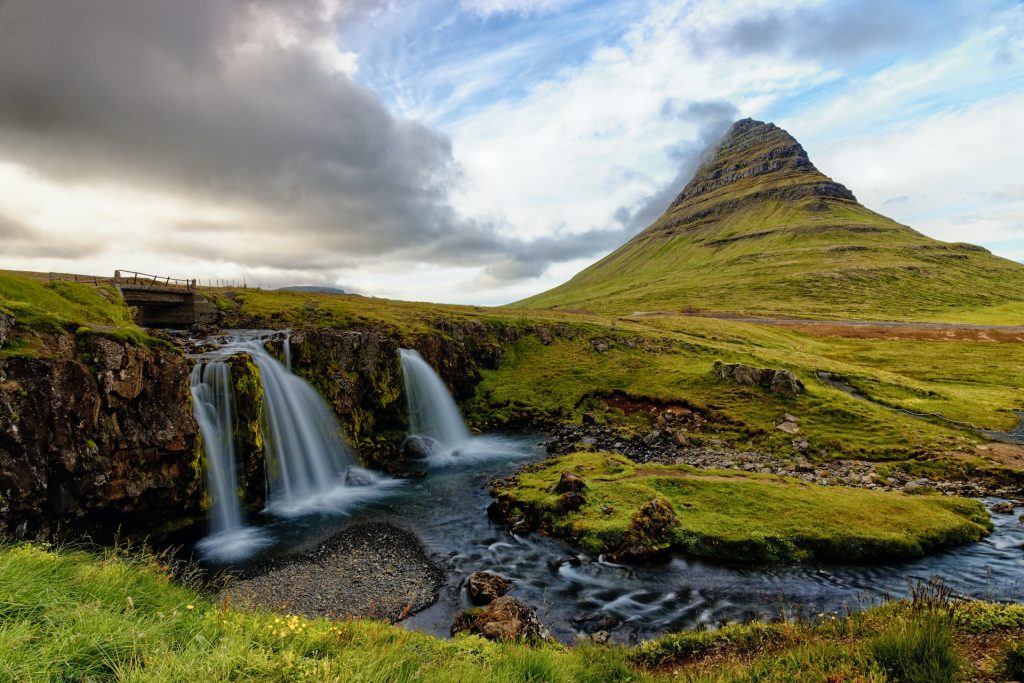

Weather and average temp in Icelandic Highlands area
The Highlands of Iceland are a vast, uninhabited wilderness of black deserts, colorful mountains, geothermal springs, and glacial rivers. Sitting at a higher elevation and well inland, this region is colder, more unpredictable, and completely closed off for most of the year due to extreme weather conditions.
Unlike other regions, there’s no permanent settlement to measure average temperatures from — but you can expect temperatures to be several degrees colder than coastal areas, especially at night. Even in the warmest month, July, daytime highs rarely exceed 10–12°C.
Seasonal note:
The Highlands are only accessible from late June to early September with a rental car, depending on snowmelt and road conditions. Always check road.is before attempting a trip, as the F-roads (mountain roads) can open or close without warning.
Estimated Highland temperature range (based on summer months)
| Month | Average High (°C) | Average Low (°C) |
| June | 6–10°C | 0–4°C |
| July | 8–12°C | 2–6°C |
| August | 7–11°C | 1–5°C |
What to expect
- Cold nights, even in summer
- Sudden weather changes — from sun to snow in one afternoon
- No mobile service, no gas stations, and river crossings required
Best car to rent for the Highlands
To legally and safely drive in the Highlands, you must rent a 4WD vehicle that is approved for F-roads. Not all SUVs qualify — so always check your rental agreement. At Hertz Iceland, we offer Highland-ready vehicles specifically designed for this rugged terrain.
This region is only suitable for summer months and adventurous drivers who are well-prepared. If you’re planning a visit to places like Landmannalaugar, Askja, or Kerlingarfjöll, a proper 4×4 is essential — and you should be comfortable with river crossings and long drives on rough terrain.
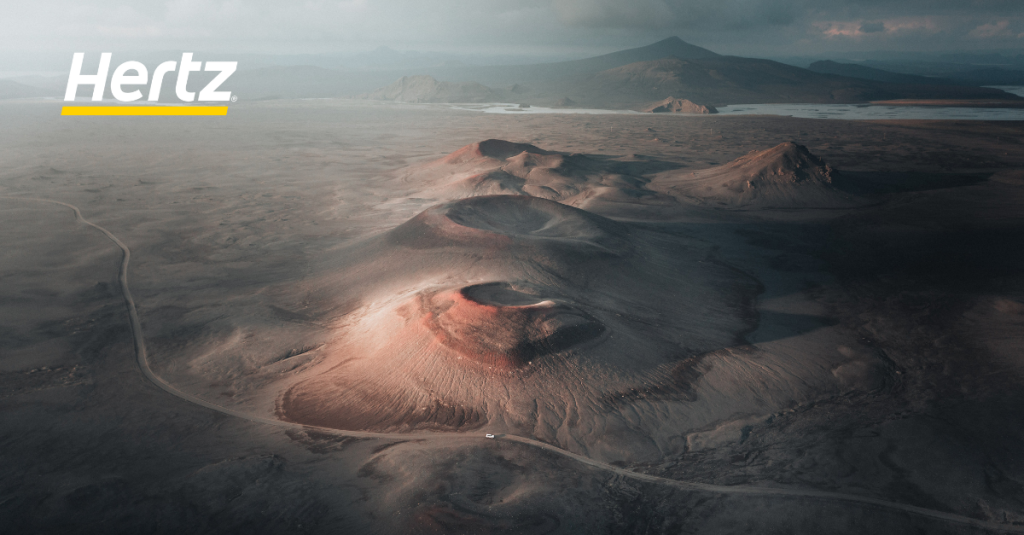
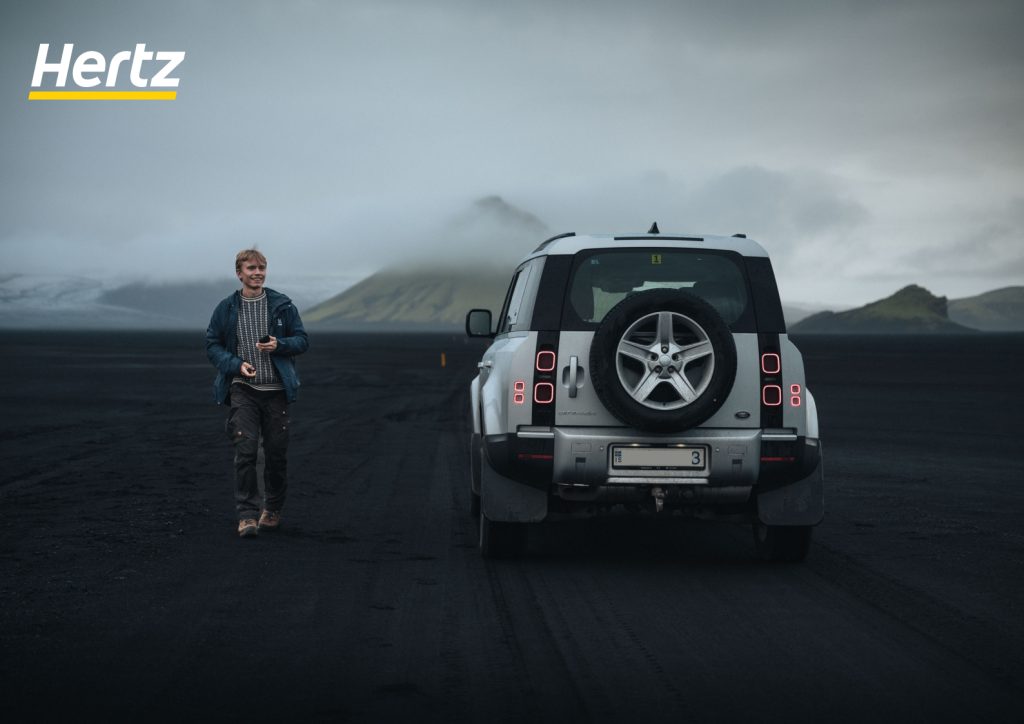
Summary: Best rental car by region and season
| Region | Season | Recommended Vehicle Type | Notes |
| Reykjavík & Capital Area | Summer (May–Sep) | 2WD (Compact/Economy) | Good roads; perfect for Golden Circle and city drives |
| Winter (Oct–Apr) | 4WD or SUV | Safer in snow, ice, and sudden weather changes | |
| South Iceland (Vík) | Summer | 2WD or SUV | Rain likely; SUV preferred if exploring further east |
| Winter | 4WD or SUV | High wind risk and icy roads; 4WD strongly advised | |
| East Iceland (Egilsstaðir) | Summer | 2WD or SUV | Hilly roads; SUV more comfortable for long drives |
| Winter | 4WD or SUV | Inland roads can be snowy and icy; 4WD essential | |
| North Iceland (Akureyri) | Summer | 2WD | Calm summer conditions; good for lake and fjord trips |
| Winter | 4WD or SUV | Frequent snow; needed if chasing northern lights in Iceland | |
| Westfjords (Ísafjörður) | Summer | 4WD | Gravel roads, remote areas — 4WD required |
| Winter | Not recommended | Roads often impassable or closed | |
| Snæfellsnes Peninsula | Summer | 2WD | Mostly paved roads; great for hot springs and coastal drives |
| Winter | 4WD | Wind and snow make 4WD a safer choice | |
| Highlands | Summer only | F-Road Approved 4WD (e.g., Toyota Land Cruiser, Dacia Bigster) | Only open Jun–Sep; river crossings and rough roads require high-clearance 4×4 |
| Winter | Not accessible | Region closed due to snow and safety risks |
Final driving tips for your Iceland road trip
Iceland’s weather might be unpredictable, but your travel plans don’t have to be. Whether you’re exploring the mild capital region or heading deep into the Highlands, knowing the climate in Iceland and how it changes across regions will help you stay safe and confident behind the wheel.
Here are a few quick reminders before you go:
- Always check weather and road conditions before your drive at vedur.is and road.is
- Pack for all seasons — even in summer, temperatures drop quickly inland and after dark
- Plan fuel stops ahead, especially in rural areas like the Eastfjords or Highlands
- Choose your rental car based on region and season, not just price — it can make all the difference between a smooth trip and a stressful one
- Consider pairing your itinerary with the right season:
- Summer months are ideal for the Highlands, hiking in Iceland, and midnight sun
- January and February offer the best chance to see the aurora borealis, but require more caution
- The wettest months (usually Oct–Mar on the south coast) demand slower driving and extra preparation
From the icy passes of the north to the volcanic deserts of the interior, Iceland’s regions each offer a different kind of magic — and the right car helps you discover it on your terms.
The road is waiting. You shouldn’t.
At Hertz Iceland, we offer everything from compact 2WDs to rugged 4x4s approved for F-roads, all under 2 years old and ready for Iceland’s changing seasons.
Whether you’re driving under the midnight sun or chasing the northern lights, we’ve got the right car for your journey.
Hertz. Let’s Go!
